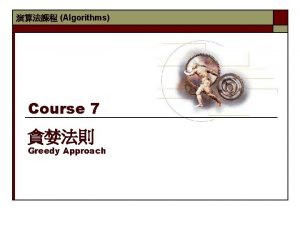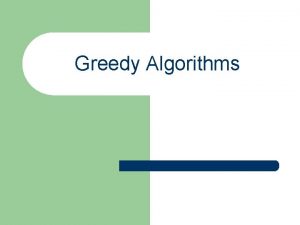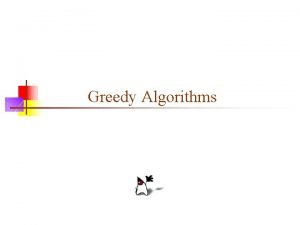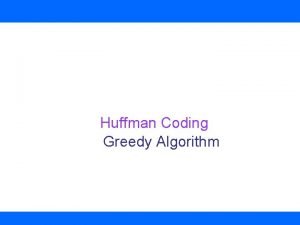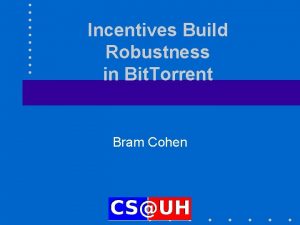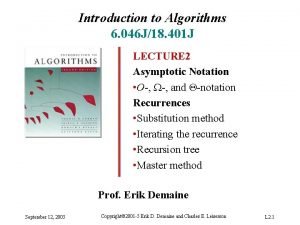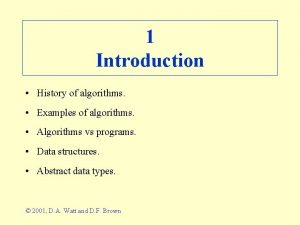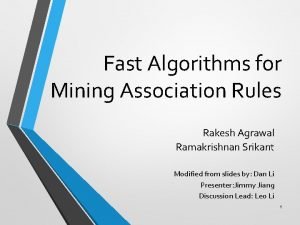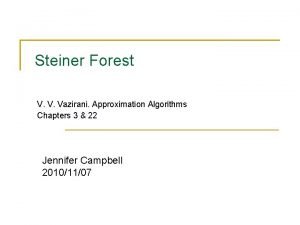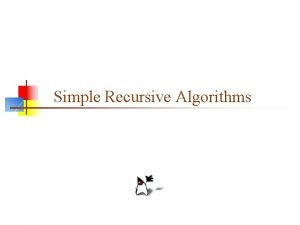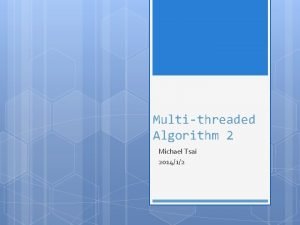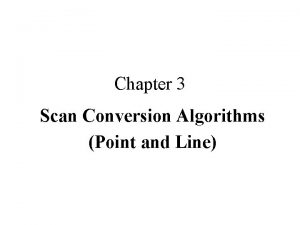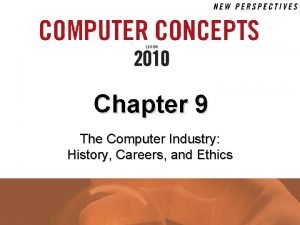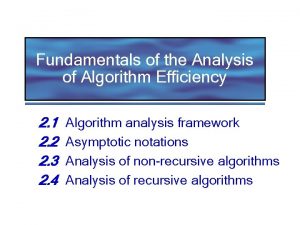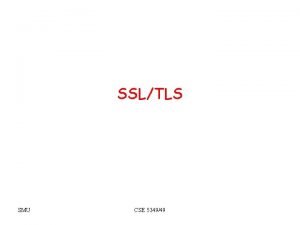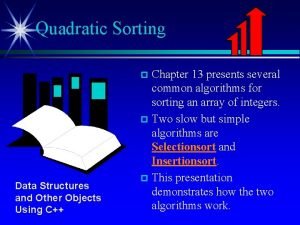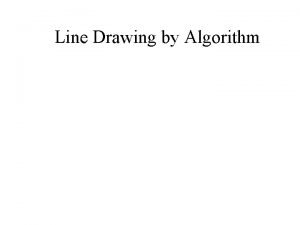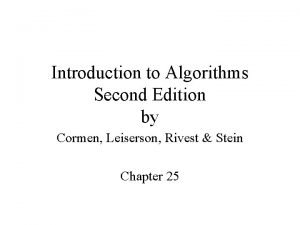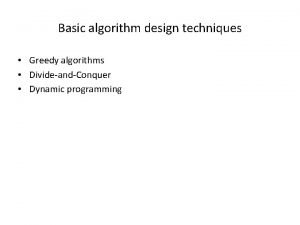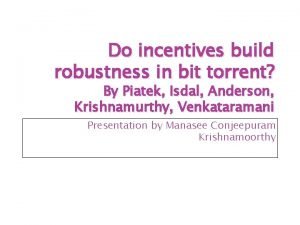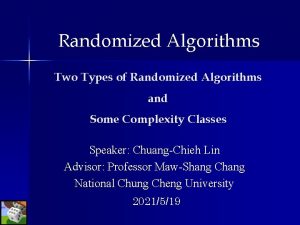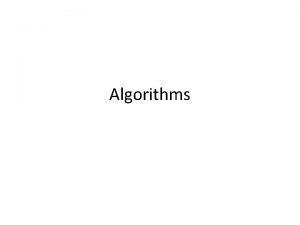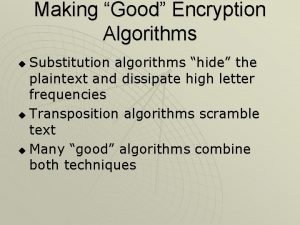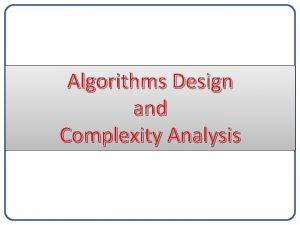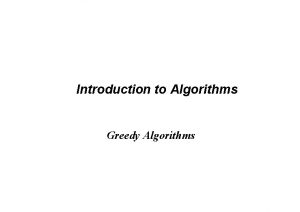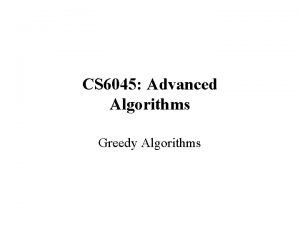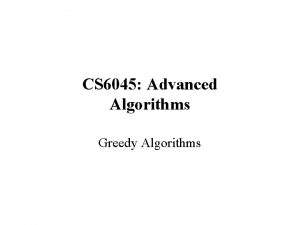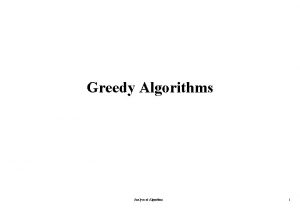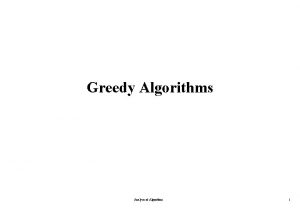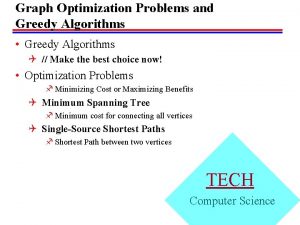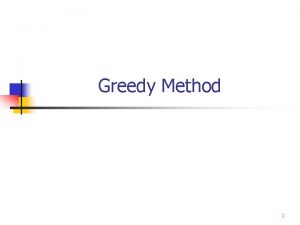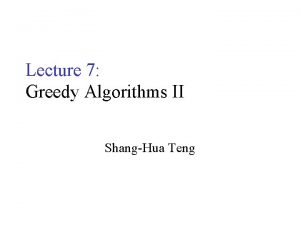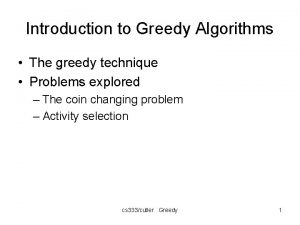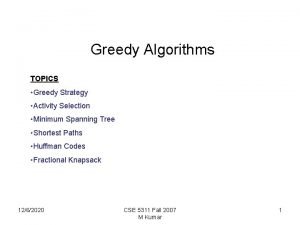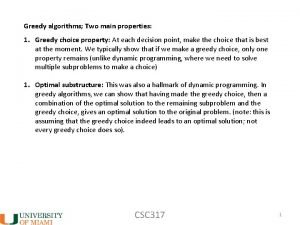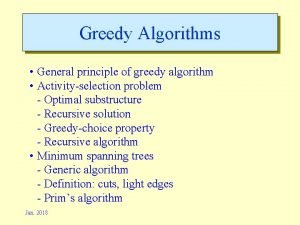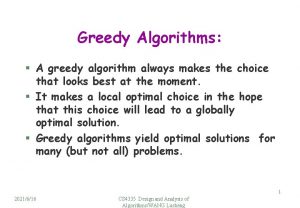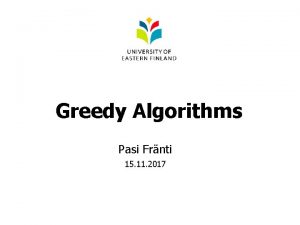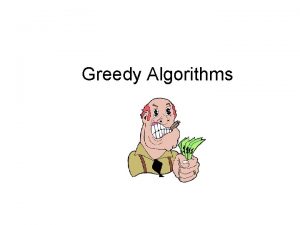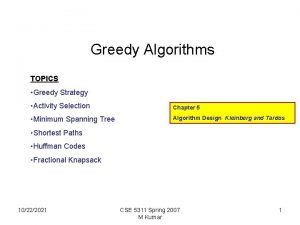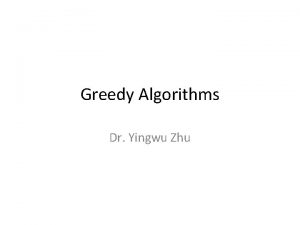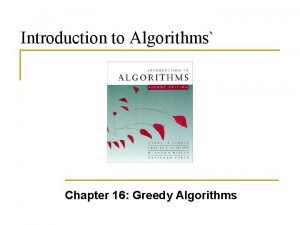Greedy Algorithms 1 Overview 2 Inventory of greedy























































- Slides: 55

Greedy Algorithms 1

Overview 2

Inventory of greedy algorithms � New problems we will see: � Coin change � Knapsack algorithm � Interval scheduling � Greedy � Prim’s algorithms we’ve already seen: MST � Kruskal’s MST � Dijkstra’s shortest path � Huffman Codes 3

Greedy Method: Overview � Optimization problems: terminology �A solution must meet certain constraints: A solution is feasible � Example: � Solutions judged on some criteria: Objective function � Example: � One All edges in solution are in graph, form a simple path Sum of edge weights in path is smallest (or more) feasible solutions that scores best (by the objective function) is the optimal solution(s) 4

Greedy Method: Overview � Greedy strategy: � Build solution by stages, adding one item to partial solution found so far � At each stage, make locally optimal choice based on the greedy rule (sometimes called the selection function) � Locally optimal, i. e. best given what info we have now � Irrevocable, a choice can’t be un-done � Sequence of locally optimal choices leads to globally optimal solution (hopefully) � Must prove this for a given problem! � Approximation algorithms, heuristics 5

Proving them correct � Given a greedy algorithm, how do you show it is optimal? � As opposed to other types of algorithms (divide-andconquer , etc. ) � One common way is to compare the solution given with an optimal solution 6

Making Change 7

Everyone Already Knows Many Algorithms! � Worked retail? You know how to make change! � Example: � My item costs $4. 37. I give you a five dollar bill. What do you give me in change? � Answer: two quarters, a dime, three pennies � Why? How do we figure that out? 8

Making Change � The problem: � Give back the right amount of change, and… � Return the fewest number of coins! � Inputs: the dollar-amount to return � Also, the set of possible coins. (Do we have half-dollars? That affects the answer we give. ) � Output: � Note a set of coins this problem transformation statement is � Given simply input, generate output with certain properties � No statement about how to do it. � Can 9 you describe the algorithm you use? a

A Change Algorithm 1. 2. 3. 4. 5. 6. 10 Consider the largest coin How many go into the amount left? Add that many of that coin to the output Subtract the amount for those coins from the amount left to return If the amount left is zero, done! If not, consider next largest coin, and go back to Step 2

Is this a “good” algorithm? � What makes an algorithm “good”? � Good time complexity. (Maybe space complexity. ) � Better than any other algorithm � Easy to understand � How could we measure how much work an algorithm does? � Code it and time it. Issues? � Count how many “instructions” it does before implementing it � Computer scientists count basic operations, and use a rough measure of this: order class, e. g. O(n lg n) 11

Evaluating Our Greedy Algorithm � How much work does it do? � Say C is the amount of change, and N is the number of coins in our coin-set � Loop at most N times, and inside the loop we do: �A division � Add something to the output list � A subtraction, and a test � We say this is O(N), or linear in terms of the size of the coin-set � Could � Is we do better? this an optimal algorithm? � We need to do a proof somehow to show this 12

Another Change Algorithm � Give me another way to do this? � Brute force: � Generate all possible combinations of coins that add up to the required amount � From these, choose the one with smallest number � What would you say about this approach? � There are other ways to solve this problem � Dynamic programming: build a table of solutions to small subproblems, work your way up 13

Algorithm for making change � � This algorithm makes change for an amount A using coins of denominations denom[1] > denom[2] > ··· > denom[n] = 1. Input Parameters: denom, A Output Parameters: None greedy_coin_change(denom, A) { i = 1 while (A > 0) { c = A / denom[i] println(“use ” + c + “ coins of denomination ” + denom[i]) A = A - c * denom[i] i = i + 1 } } 14

Making change proof � Prove that the provided making change algorithm is optimal for denominations 1, 5, and 10 � Via 15 induction, and on board -->

Formal proof � Formal proof of the change problem � Algorithm 7. 1. 1 is what is presented two slides previously 16

How would a failed proof work? � Prove that the provided making change algorithm is optimal for denominations 1, 6, and 10 � Via 17 induction, and on board -->

Knapsack Algorithm 18

Knapsack Problems � Motivated by a theoretical burglary scenario (realistically motivated by other similar problems) �A thief breaks into a house and must gather as many precious items as possible. � BUT…he cannot gather items, the total weight of which, exceeds the capacity of his knapsack. 19

Knapsack Problems � Inputs: �n items, each with a weight wi and a value vi � capacity of the knapsack, C � Output: � Fractions � Or…the � Chosen for each of the n items, xi actual weights of each item taken to maximize total profit but not to exceed knapsack capacity 20

Two Types of Knapsack Problem � 0/1 knapsack problem (or discrete knapsack) � Each item is discrete. Must choose all of it or none of it. So each xi is 0 or 1 � Greedy approach does not produce optimal solutions � But another approach, dynamic programming, does �Continuous � Can knapsack problem pick up fractions of each item � The correct selection function yields a greedy algorithm that produces optimal results 21

Greedy Rule for Knapsack? � Build up a partial solution by choosing xi for one item until knapsack is full (or no more items). Which item to choose? � There are several choices. Pick one and try on this: �n = 3, C = 20 � weights = (18, 15, 10) � values = (25, 24, 15) � What answer do you get? � The optimal answer is: (0, 1, 0. 5), total=31. 5 � Can 22 you verify this?

Possible Greedy Rules for Knapsack � Build up a partial solution by choosing xi for one item until knapsack is full (or no more items). Which item to choose? � Maybe this: take as much as possible of the remaining item that has largest value, vi � Or maybe this: take as much as possible of the remaining items that has smallest weight, wi � Neither of these produce optimal values! The one that does “combines” these two approaches. � Use 23 ratio of profit-to-weight

Example Knapsack Problem � For this example: �n = 3, C = 20 � weights = (18, 15, 10) � values = (25, 24, 15) � Ratios � The 24 = (25/18, 24/15, 15/10) = (1. 39, 1. 6, 1. 5) optimal answer is: (0, 1, 0. 5)

Continuous knapsack algorithm � a is an array containing the items to be put into the knapsack. Each element has the following fields: continuous_knapsack(a, C) n = a. last � p: the profit for that item for i = 1 to n � w: the weight for that item ratio[i] = a[i]. p / a[i]. w � id: the identifier for that item sort (a, ratio) � C is the capacity of the weight = 0 knapsack i=1 � What is the running time? while ( i ≤ n && weight < C ) if ( weight + a[i]. w ≤ C ) println (“select all of object “ + a[i]. id) weight = weight + a[i]. w else r = (C – weight) / a[i]. w println (“select “ + r + “ of object “ + a[i]. id) weight = C 25 i++

How do we know it’s correct? � Proof � On 26 time!!! board -->

How do we know it’s correct? � Proof 27 time!!!

Interval Selection 28

Activity-Selection Problem � Problem: You and your classmates go on Semester at Sea � Many exciting activities each morning � Each starting and ending at different times � Maximize your “education” by doing as many as possible. (They’re all equally good!) � Welcome � Also 29 to the activity selection problem called interval scheduling

The Activities! Id Start End Activity 1 9: 00 10: 45 Fractals, Recursion and Crayolas 2 9: 15 10: 15 3 9: 30 12: 30 Tropical Drink Engineering with Prof. Bloomfield Managing Keyboard Fatigue with Swedish Massage 4 9: 45 10: 30 5 9: 45 11: 15 Applied Chem. E: Suntan Oil or Lotion? Optimization, Greedy Algorithms, and the Buffet Line 6 10: 15 11: 00 Hydrodynamics and Surfing 7 10: 15 11: 30 Computational Genetics and Infectious Diseases 8 10: 30 11: 45 Turing Award Speech Karaoke 9 11: 00 12: 00 Pool Tanning for Engineers 10 11: 00 12: 15 Mechanics, Dynamics and Shuffleboard Physics 11 12: 00 12: 45 Discrete Math Applications in Gambling 30

Generalizing Start, End Id Start End Len Activity 1 0 6 7 2 1 4 4 3 2 13 Tropical Drink Engineering with Prof. Bloomfield Managing Keyboard Fatigue with Swedish 12 Massage 4 3 5 3 8 6 Applied Chem. E: Suntan Oil or Lotion? Optimization, Greedy Algorithms, and the Buffet Line 6 5 7 3 Hydrodynamics and Surfing 7 5 9 5 Computational Genetics and Infectious Diseases 8 6 10 5 Turing Award Speech Karaoke 9 8 11 4 Pool Tanning for Engineers 10 8 12 5 Mechanics, Dynamics and Shuffleboard Physics 11 12 14 3 Discrete Math Applications in Gambling 31 Fractals, Recursion and Crayolas

Greedy Approach 1. 2. 3. 4. Select a first item. Eliminate items that are incompatible with that item. (i. e. they overlap. ) Apply the greedy rule (AKA selection function) to pick the next item. Go to Step 2 What is a good greedy rule for selecting the next item? 32

Some Possibilities � Pick the next compatible one that starts earliest � Pick the shortest one � Pick the one that has the least conflicts (i. e. overlaps) � Do 33 any of these work? Counter-examples?

Activity-Selection � Formally: � Given a set S of n activities � si = start time of activity i � fi = finish time of activity i � Find max-size subset A of compatible activities 3 4 6 2 1 � Assume 34 5 (wlog) that f 1 f 2 … fn

Activity Selection: A Greedy Algorithm � So actual algorithm is simple: � Sort the activities by finish time � Schedule the first activity � Then schedule the next activity in sorted list which starts after previous activity finishes � Repeat until no more activities � Intuition � Always 35 is even more simple: pick next activity that finishes earliest

Activity Selection: Optimal Substructure � Let k be the minimum activity in A (i. e. , the one with the earliest finish time). Then A - {k} is an optimal solution to S’ = {i S: si fk} � In words: once activity #1 is selected, the problem reduces to finding an optimal solution for activity-selection over activities in S compatible with #1 � Proof: if we could find optimal solution B’ to S’ with |B’| > |A - {k}|, B’ U {k} is compatible � And |B’ U {k}| > |A|, which is a contradiction � Then 36

Back to Semester at Sea… Id Start End Len Activity 2 1 4 4 Tropical Drink Engineering with Prof. Bloomfield 4 3 5 3 Applied Chem. E: Suntan Oil or Lotion? 1 0 6 7 Fractals, Recursion and Crayolas 6 5 7 3 5 3 8 6 Hydrodynamics and Surfing Optimization, Greedy Algorithms, and the Buffet Line 7 5 9 5 Computational Genetics and Infectious Diseases 8 6 10 5 Turing Award Speech Karaoke 9 8 11 4 Pool Tanning for Engineers 10 8 12 5 3 2 13 Mechanics, Dynamics and Shuffleboard Physics Managing Keyboard Fatigue with Swedish 12 Massage 11 12 14 3 Solution: 2, 6, 9, 11 37 Discrete Math Applications in Gambling

Visualizing these Activities ID Start End 1 0 6 2 1 4 3 2 13 4 3 5 5 3 8 6 5 7 7 5 9 8 6 10 9 8 11 10 8 12 11 12 14 38 0 1 2 3 4 5 6 7 8 9 10 11 12 13 14

Visualizing these Activities ID Start End 1 0 6 2 1 4 3 2 13 4 3 5 5 3 8 6 5 7 7 5 9 8 6 10 9 8 11 10 8 12 11 12 14 39 0 1 2 3 4 5 6 7 8 9 10 11 12 13 14

Sorted, Then Showing Selection and Incompatibilities ID Start End 2 1 4 3 1 0 6 5 5 3 7 5 8 6 9 8 10 8 3 2 11 12 40 4 5 6 7 8 9 10 11 12 13 14 0 1 2 3 4 5 6 7 8 9 10 11 12 13 14 Select solid-colored item, Eliminates activities X’d out of same color

Interval selection algorithm greedy-interval (s, f) n = s. length A = {a 1} k=1 for m = 2 to n if s[m] ≥ f[k] A = A U {am} k=m return A 41 �s is an array of the intervals’ start times � f is an array of the intervals’ finish times � A is the array of the intervals to schedule � How long does this take?

The proof… � On board --> � Show that the greedy algorithm stays ahead! 42

Interval Coloring 43

Interval Coloring � Problem Statement: � Given a set of intervals I, assign a color to each one such no two intervals of the same color overlap. Goal is to return the coloring that contains minimum number of unique colors � More Realistic Examples: � Assigning classrooms given class start, end requests using minimum number of rooms � Minimum number of planes needed to fulfill a set of flights � etc. 44

Interval Coloring � Some observations that will help lead to a solution: � Input looks very similar to interval scheduling. Thus, running interval scheduling will get us a maximum number of intervals that can be assigned a single color. � At any specific time point t, there a maximum of S intervals that overlap at that exact time. Clearly the solution N must be at least S. Why? � Is 45 it the case that the solution IS always S?

Interval Coloring � Potential Solution: � Sort intervals by finish time � num. Colors = 0 � While more intervals left to color: � num. Colors++ � Run greedy interval scheduling algorithm and color those with next color � Remove those intervals from the set � Repeat � Solution 46 is num. Colors

Interval Coloring � Does � We this algorithm work? know that absolute lowest bound on solution is S (defined in previous slides) � …and we know the sub-routine interval scheduling is optimal (from last proof) � …so, if we can simply show that the loop runs exactly S times, then that is sufficient. 47

The proof… � On 48 board -->

Conclusion 49

Greedy algorithm summary � Algorithms we saw: � Coin change � Knapsack algorithm � Interval scheduling � Other greedy algorithms we’ve seen previously: � Prim’s MST � Kruskal’s MST � Dijkstra’s shortest path � Huffman Codes 50

Greedy Method: Overview � Optimization � Solutions problems: terminology judged on some criteria: Objective function � Example: Sum of edge weights in path is smallest �A solution must meet certain constraints: A solution is feasible � Example: � One All edges in solution are in graph, form a simple path (or more) feasible solutions that scores highest (by the objective function) is the optimal solution(s) 51

Greedy Method: Overview � Greedy strategy: � Build solution by stages, adding one item to partial solution found so far � At each stage, make locally optimal choice based on the greedy rule (sometimes called the selection function) � Locally optimal, i. e. best given what info we have now � Irrevocable, a choice can’t be un-done � Sequence of locally optimal choices leads to globally optimal solution (hopefully) � Must prove this for a given problem! � Approximation algorithms, heuristics 52

Proving them correct � Given a greedy algorithm, how do you show it is optimal? � As opposed to other types of algorithms (divide-andconquer , etc. ) � One way is to compare the solution given with an optimal solution � Another way is through induction 53

Proving a greedy algorithm is correct Show that it fulfills the greedy-choice property 1. � Does making a greedy choice at any arbitrary point yield an optimal solution? � Consider an optimal solution to a sub-problem � Show that making the greedy choice will yield an optimal solution to the overall problem Show that it has optimal sub-structure 2. � Show that a solution to a problem contains optimal solutions to sub-problems � Or 54 use a general proof that compares !

Warning! � Proving that an algorithm makes a greedy choice at each stage is NOT the same as showing that the algorithm has the greedy choice property � The first is a property of the algorithm designed � The second shows that making the greedy choice will yield an optimal solution to the overall problem 55
 Greedy algorithm
Greedy algorithm Greedy algorithm
Greedy algorithm N/a greedy
N/a greedy Greedy huffman coding
Greedy huffman coding La decision de anne torrent
La decision de anne torrent Introduction to algorithms
Introduction to algorithms History of algorithms
History of algorithms Fast algorithms for mining association rules
Fast algorithms for mining association rules Data structures and algorithms
Data structures and algorithms Vazirani approximation algorithms
Vazirani approximation algorithms Information retrieval data structures and algorithms
Information retrieval data structures and algorithms Alternative algorithms for subtraction
Alternative algorithms for subtraction Nature-inspired learning algorithms
Nature-inspired learning algorithms Explain inode life cycle with ialloc(), iput() algorithms.
Explain inode life cycle with ialloc(), iput() algorithms. Input and output in algorithm
Input and output in algorithm 15-853 algorithms in the real world
15-853 algorithms in the real world Delivery routing algorithms
Delivery routing algorithms Association analysis: basic concepts and algorithms
Association analysis: basic concepts and algorithms List of recursive algorithms
List of recursive algorithms 15-853 algorithms in the real world
15-853 algorithms in the real world Multithreaded algorithms
Multithreaded algorithms Define scan conversion
Define scan conversion A manual calculator implements algorithms autonomously.
A manual calculator implements algorithms autonomously. Professor ajit diwan
Professor ajit diwan Fundamentals of analysis of algorithm efficiency
Fundamentals of analysis of algorithm efficiency Smu handshake
Smu handshake Design and analysis of algorithms
Design and analysis of algorithms Analysis of algorithms lecture notes
Analysis of algorithms lecture notes Introduction to algorithms lecture notes
Introduction to algorithms lecture notes Quadratic sorting algorithms
Quadratic sorting algorithms Simbol data
Simbol data Algorithms and flowcharts
Algorithms and flowcharts Lamarckian evolution
Lamarckian evolution Dda algorithm pseudocode
Dda algorithm pseudocode Worksheet 2 searching algorithms answers
Worksheet 2 searching algorithms answers Boris epshtein
Boris epshtein Algorithms + data structures = programs
Algorithms + data structures = programs Memory management algorithms
Memory management algorithms Introduction to algorithms 2nd edition
Introduction to algorithms 2nd edition Algorithm design techniques
Algorithm design techniques Computer networks routing algorithms
Computer networks routing algorithms Incentives build robustness in bittorrent
Incentives build robustness in bittorrent Types of randomized algorithms
Types of randomized algorithms Incrementalizing graph algorithms
Incrementalizing graph algorithms Global illumination algorithms
Global illumination algorithms Definition of algorithms
Definition of algorithms Dsp programming tutorial
Dsp programming tutorial Global optimization toolbox
Global optimization toolbox Design and analysis of algorithms
Design and analysis of algorithms Cluster analysis basic concepts and algorithms
Cluster analysis basic concepts and algorithms Making good encryption algorithms
Making good encryption algorithms How to find complexity of algorithm
How to find complexity of algorithm Line drawing algorithm computer graphics
Line drawing algorithm computer graphics Motion estimation algorithms
Motion estimation algorithms Ajit diwan iit bombay
Ajit diwan iit bombay Space complexity bfs
Space complexity bfs
